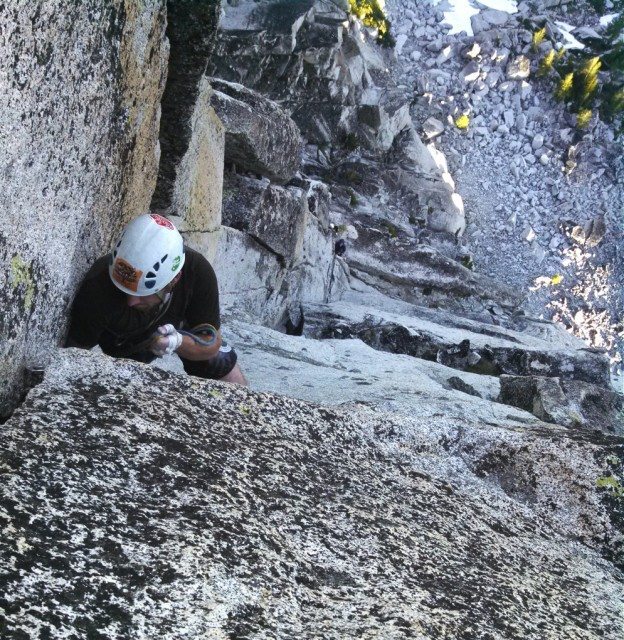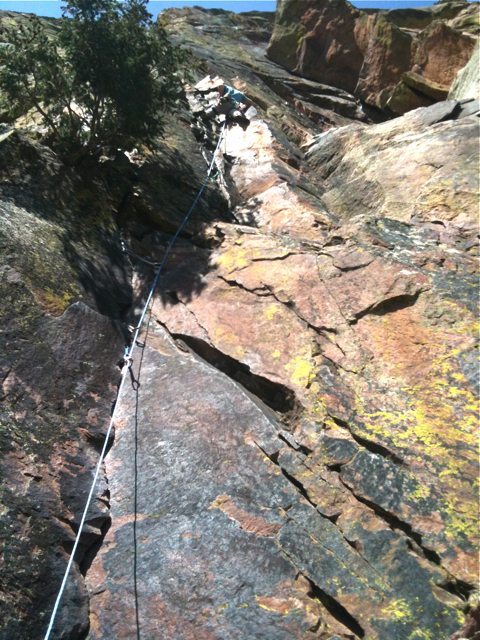
Mammut Infinity Single Rope, 9.5mm
Elongation at First Fall: 30
Elongation with 80 kg: 6.8%
UIAA falls: 8-9
Sheat Slippage: 0mm
Impact Force: 8.7 kN
Weight: 58g/m
MSRP: $240
Days Tested: 20+ days
Locations Tested: Eldorado, Rocky Mountain National Park, Washington state
The Infinity 9.5mm single by Mammut has gained a strong following over the years and stands out among Mammut’s extensive catalog of ropes. At 9.5mm, the Infinity is somewhat of an oddity—most mid-weight single ropes check in at 9.4mm or 9.6mm, and only a few major manufacturers make 9.5mm cords.
Without getting too hung up on a 0.1mm difference in diameter, I think the Infinity is part of Mammut’s deliberate attempt to toe the line between workhouse single ropes (roughly 9.7mm and thicker) and high-end singles (approximately 9.4mm and thinner).
This Infinity is thin and light enough that you can reach for it on harder sport pitches, but it’s durable enough you don’t have to obsess over its condition.
Handling
The Infinity’s handling is one of the its greatest attributes. The sheath is soft (out of the box this is typically due to the weave, though certain coatings or lack thereof can accumulate dust and debris, and affect smoothness. More on this below.), and feeds through both ATC-type belay devices and gri-gris fluidly. The rope is easy to brake with an ATC and rappels quickly, but not perilously.
Dry Treatment
My past experience has left me somewhat averse to dry treatments for dedicated rock climbing ropes. While extremely useful in alpine, glacier, or ice climbing settings, running a rope across rock surfaces tends to quickly strip it of its coating.
At the same time, several dry ropes I’ve owned (I’m looking at you, Mammut Tusk), used various dry treatments at the expense of handling. A dry treatment shouldn’t sacrifice handling, in my opinion, especially since the outer coating wears off relatively quickly during normal use.
Because of this, I approached the standard “COATINGfinish” dry treatment on the Infinity with some degree of skepticism (can’t I get a non-dry version?), but I’ll admit that my fears were unfounded. The Infinity handled incredibly well right out of the box, and its performance didn’t decrease over the course of the season.

PTFE coating
The treatment on the Infinity is a PTFE-based coating for both the sheath and the core fibers. PTFE (polytetrafluoroethylene—better known under the trademark “Teflon”), has one of the lowest known coefficients of friction against other solids. It is relatively inert, hydrophobic, and often used to lubricate certain surfaces, particularly when heat sensitivity (machine parts, etc.) is a concern.
All of these factors make it a good candidate for climbing rope treatments, and it appears in various coatings across the industry. The exact composition of a dry treatment, however, is often proprietary information, making it difficult to compare one dry treatment with another without testing the rope.
PTFE on a rope’s sheath fibers helps repel water, which, if absorbed, can make a rope extremely heavy and decrease its strength. Sheath coatings also help keep out dirt, the accumulation of which can shorten a rope’s life expectancy.
When PTFE or other dry coatings are applied to the core fibers, they reduce internal friction when the rope is loaded. The stress on the fibers can create stress gradients within the rope, resulting in uneven load distribution. Reducing this stress helps the core fibers bear the load of a fall more evenly and, at least in theory, improves the lifetime of the rope. How well this works is difficult to say from any real-world testing (you’d need to destroy the rope in a lab and then subject it to various experiments).
What I can tell you from testing the Infinity is that this fiber treatment doesn’t come at the expense of handling, as is often the case, and that the rope held up to a season of abuse extremely well. How much of this, if any, can be attributed to the dry treatment is anybody’s guess.
Durability
The guts of the Infinity include a sheath that accounts for a generous 40% of the rope’s weight—sufficient to expect a decent lifetime given standard use. After using the Infinity on both single and multipitch outings over the course of one full season, I can say I’d expect a couple more seasons from this rope.
To be fair, I relied on a pair of Mammut Tusks during my most unforgiving (on the rope, anyway) cragging sessions. I saved the Infinity mostly for lead climbing, and long days in Eldorado, Rocky Mountain National Park, and various alpine and crag locales around Washington state. That said, the rope looked and handled really well throughout the season.
Choosing the Right Diameter
My personal criteria for do-it-all single ropes includes good handling, smooth feeding, and some degree of durability. I don’t want to feel like I’m unwinding a slinky (like I do every time my stiffer ropes get kinked, which is often), but I’m not willing to retire multiple ropes per season just to avoid this problem.
Mid-weight single ropes such as the Infinity aren’t ideal for beginners or for dedicated cragging, in my opinion. If you want a rope to set up endless top ropes, take your friends to the crag, teach people how to climb, and otherwise beat into oblivion, then you want something more robust. Thicker diameters (9.8mm+), and higher sheath/core ratios are your friend.
Alternatively, if you’re pushing grades on single pitch routes and want the lightest rope possible to dedicate to your send attempts, then you can go thinner and lighter than the Infinity. Modern advancements in materials and weaves have permitted the construction of some very thin single lines (like the 8.6mm Corbie that Edelrid debuted at this year’s Outdoor Retailer Summer Market), many of which are now rated for half and twin rope use as well. These are your specialist sending lines.
But while these really thin, high-performance single lines (in the 9.2mm or lower range), are great if you think you’re getting close to a send, they’re a bit thinner than I like for regular use. I spend a lot of time dogging up routes that are too hard for me and I don’t want to constantly retire super thin single ropes, as slick as they are. I don’t need that many climbing rope rugs in my house.

On the Rock
If you use these parameters as a guide, the Infinity is an awesome rope. At 9.5mm, it’s right in the middle of the range covered by modern single ropes (though some newer sub-9mm singles are starting to make 9.5mm look downright bulky).
This puts it in the “do-it-all” category of ropes. At 58g/m, it’s light for its category, and it has the most fluid handling of any single rope I’ve used. The diameter and weight are slim enough that it became my go-to rope for multi-pitch climbs in Eldorado where the full-length rappels offered by half ropes are rarely needed.
I also brought the Infinity on a 10-day trip to Washington state where it accompanied me up the Stanley-Burgner on Prusik Peak (along with one half rope in order to bring up two followers in tandem). I also used it for some single pitch trad cragging at the Index town walls. The Infinity was ideal at the town walls, and worked as well in the alpine as a single rope can be expected to, though in this category, it’s simply out-gunned by the versatility of most half-rope systems.
Bottom Line
If you’re looking to push grades on some high-end sport routes, you might not want the added weight of a do-it-all rope like the Infinity. Modern rope technology has allowed single ropes to slim down below 9mm with significant weight savings.
If you’re looking for your first rope, I would recommend grabbing one that’s a bit thicker and will fare better during your first months learning to climb. Most beginners won’t be held back by a little extra weight, so choosing something with a very long life expectancy is more pragmatic (i.e., “cheaper”) than getting an Infinity right away.
But if you’re first rope is starting to fray or lose some of its bounce and you’re in the market for a new one, then the Infinity is hard to beat.
I was extremely impressed by its handling and performance in all non-specialty scenarios and, from a durability standpoint, it still looked very good after a whole season of climbing. The Infinity sets the bar for the “one-rope quiver” pretty high, and it’ll be exciting to see if this new, thinner generation can top it.
